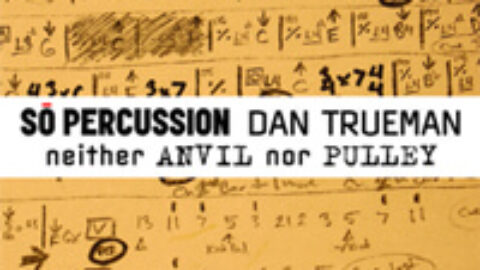 Dan Trueman‘s neither Anvil nor Pulley (“nAnP”) opens with the old-fashioned crackle of a vinyl record. The LP’s steady spin releases a plaintive violin melody – a recording of Trueman himself, playing a Norwegian Hardanger fiddle. With Trueman’s tunes as a foundation, other sonic layers begin to creep into the ear. Joyous melodies float from vibraphone and steel drum. This duo is joined by a flurry of percussive taps from a drum kit augmented with a plastic toy tambourine. Later, nAnP ventures into the electronic realm, blending traditional instruments with several of Trueman’s high-tech musical gadgets, including a digital “synchronic metronome” and a bass drum outfitted with a modified speaker driver.
Dan Trueman‘s neither Anvil nor Pulley (“nAnP”) opens with the old-fashioned crackle of a vinyl record. The LP’s steady spin releases a plaintive violin melody – a recording of Trueman himself, playing a Norwegian Hardanger fiddle. With Trueman’s tunes as a foundation, other sonic layers begin to creep into the ear. Joyous melodies float from vibraphone and steel drum. This duo is joined by a flurry of percussive taps from a drum kit augmented with a plastic toy tambourine. Later, nAnP ventures into the electronic realm, blending traditional instruments with several of Trueman’s high-tech musical gadgets, including a digital “synchronic metronome” and a bass drum outfitted with a modified speaker driver.

Created in collaboration with Brooklyn-based quartet So Percussion, nAnP provides a compelling vision of 21st century music-making, where boundaries between digital and acoustic universes dissolve and beguiling new soundscapes arise from the musical melting pot. Trueman covers much ground with nAnP’s five movements, mixing live and recorded elements while exploring rhythm, ostinato, and timbre through an artfully-curated ensemble of percussion instruments, including a few of his own inventions. On June 8, Trueman and So Percussion celebrate the release of their recording of nAnP with a concert at the Metropolitan Museum of Art. Though the recording itself is a compelling listen, nAnP is a work that begs to be experienced live, if only to answer the question, “How in the world do they make that sound?”
Beyond that simple query lies a complex web of connections between physical gesture, material object, and musical noise. As much a choreography as musical work, nAnP is best appreciated while watching So Percussion in action. In the work’s second movement, drolly titled “120bpm [or What is Your Metronome Thinking]”, each member of the quartet wields a pair of xylophone mallets used to produce sound from every imaginable type of surface, from drums and cymbals to old boards and empty Coke bottles. The resulting tapestry of interwoven rhythms is dazzling on its own, but soon gains a new, darker character with the addition of a chorus of electronic hums and wails.
To create these sounds, a percussionist grasps the two pull-cords of a golf video game controller – converted into a music-making device – and extends the strings to their full length, raising the tethers above his head. As the tethers emerge from the controller, the device analyzes a pre-loaded sound sample, zooming in on a specific part of the track depending on the amount of extension. The sound is stopped by dramatically releasing the tethers, causing them to immediately retract into the controller. By the end of “120bpm”, a full quartet of video game controllers has taken over, producing an eerie ringing. Grasping the controllers’ pull-cords, their arms fully raised in the air, the four musicians of So Percussion resemble puppet-masters directing an army of invisible marionettes.
A popular element of laptop orchestras (including Trueman’s own Princeton Laptop Orchestra), the golf video game controller is just one example of Trueman’s penchant for repurposing old gadgets, converting them into musical instruments. A tinkerer at heart, Trueman invented several new musical toys for nAnP. One of these is his “synchronic metronome”, which also figures prominently in “120bpm”. Like a standard metronome, this laptop-based device is the source of the insistent ticking heard throughout the movement, but with the added ability to shift pitch and timbre.
Other electronic instruments make appearances in nAnP, including a bass drum outfitted with speaker drivers that turn it into a gigantic resonance chamber. The drum plays an important role in the fourth movement, “Feedback [in Which a Famous Bach Prelude becomes Ill-Tempered]”. It’s fascinating to watch this modified instrument being played in So Percussion’s nAnP music video. With one microphone in hand and another draped around his neck, So Percussion’s Josh Quillen concentrates intently as he twists metal lugs around the large drum’s rim, adjusting the instrument’s pitch while tapping the microphone on the drum head. The sequence of pitches follows the melody of Bach’s ubiquitous C Major Prelude.
 The resulting feedback creates a backdrop for an exploration of drones and ostinato, including shimmering tones created by stroking vibraphone bars and cymbals with a violin bow. At the 16-minute movement’s end, a bustling rhythm emerges from a drum kit, creating a flurry of beats and cymbal crashes that accompanies the bass drum as it fades away into silence. Though it takes some time to sink into its enveloping arms, “Feedback” creates a constantly-evolving sonic landscape evocative of floating clouds or whirling galaxies of stars. This is immersive music that invites listeners to lose themselves in a mesmerizing world of noise.
The resulting feedback creates a backdrop for an exploration of drones and ostinato, including shimmering tones created by stroking vibraphone bars and cymbals with a violin bow. At the 16-minute movement’s end, a bustling rhythm emerges from a drum kit, creating a flurry of beats and cymbal crashes that accompanies the bass drum as it fades away into silence. Though it takes some time to sink into its enveloping arms, “Feedback” creates a constantly-evolving sonic landscape evocative of floating clouds or whirling galaxies of stars. This is immersive music that invites listeners to lose themselves in a mesmerizing world of noise.
The rhythmic explorations and droning pitches of “120bpm” and “Feedback” are balanced by a trio of shorter movements that focus on melody and harmony. The buoyant duet of steel drum and vibraphone remains a constant, lifting the piece up from the darker and more serious movements. In nAnP‘s final movement, “Hang Dog Springar [a Slow Dance]”, So Percussion accompanies a vinyl record playing Trueman’s fiddle tunes. The light-hearted steel drum and vibraphone are joined by the whisk of brush on drum kit, while the metallic boom of hand-struck piano strings adds a little sonority to the mix. As Trueman’s fiddle finishes its warbling, a percussionist removes the needle from the record, a symbolic gesture of finality that brings the piece to a satisfying close.
Trueman’s unusual title for the work hints at underlying questions about the role of modern-day technology in both music-making and everyday life. Unlike anvil or pulley, a computer’s mechanism is hidden in chips, wires, bits, and bytes. As the dominant musical instrument of the 21st century, can this complex machine exist in harmony with simpler musical mechanisms of earlier eras? As we dig deeper, how will we view our relationship with computers and the worlds they enable us to construct? With nAnP, Trueman presents a potential musical future – full of color, whimsy, and emotion – where technology serves as the gateway to unlocking an entire universe of novel sounds.
So Percussion, Dan Trueman: neither Anvil nor Pulley (Cantaloupe, 2013) Buy on Amazon US | Amazon UK
























